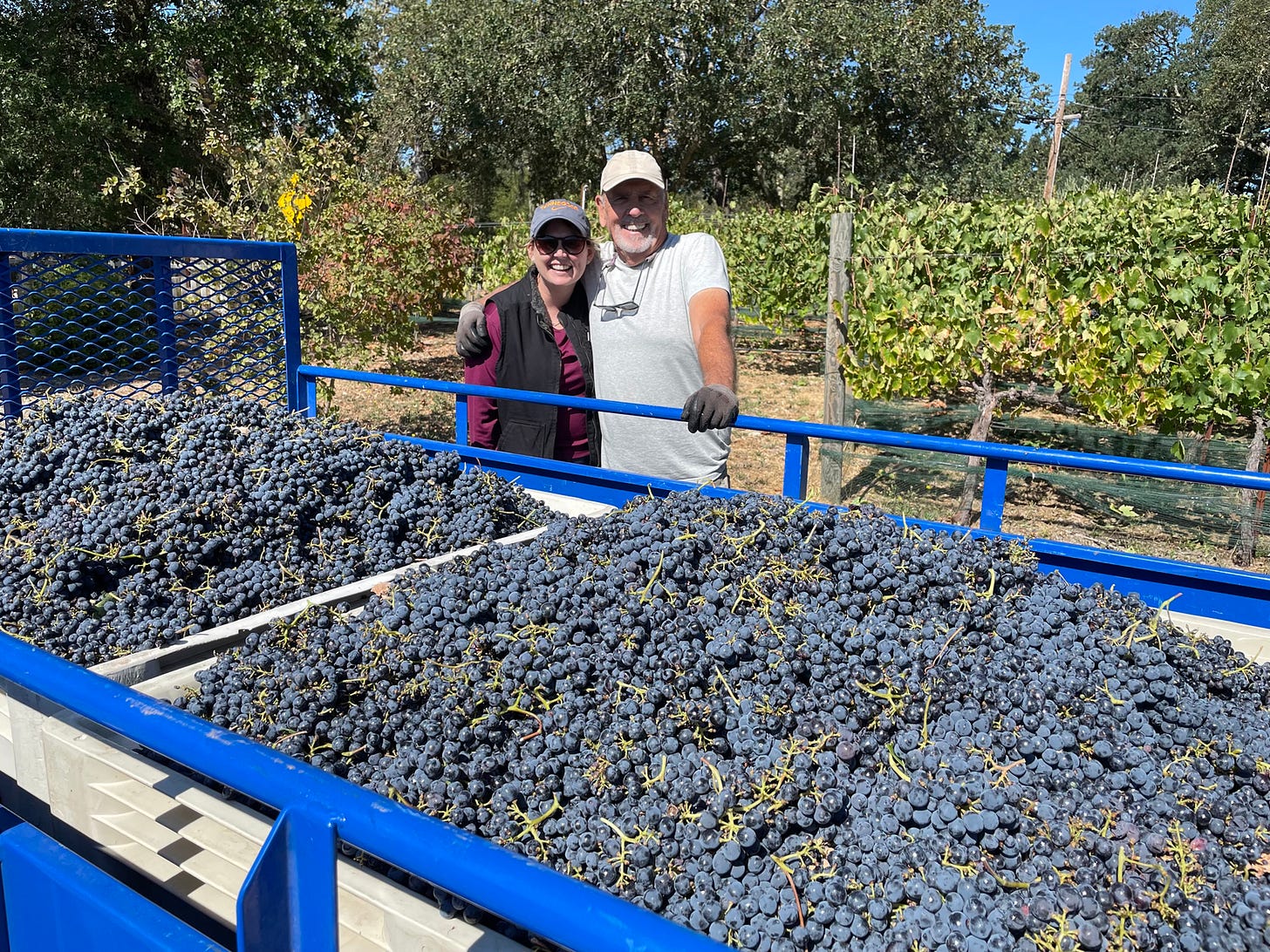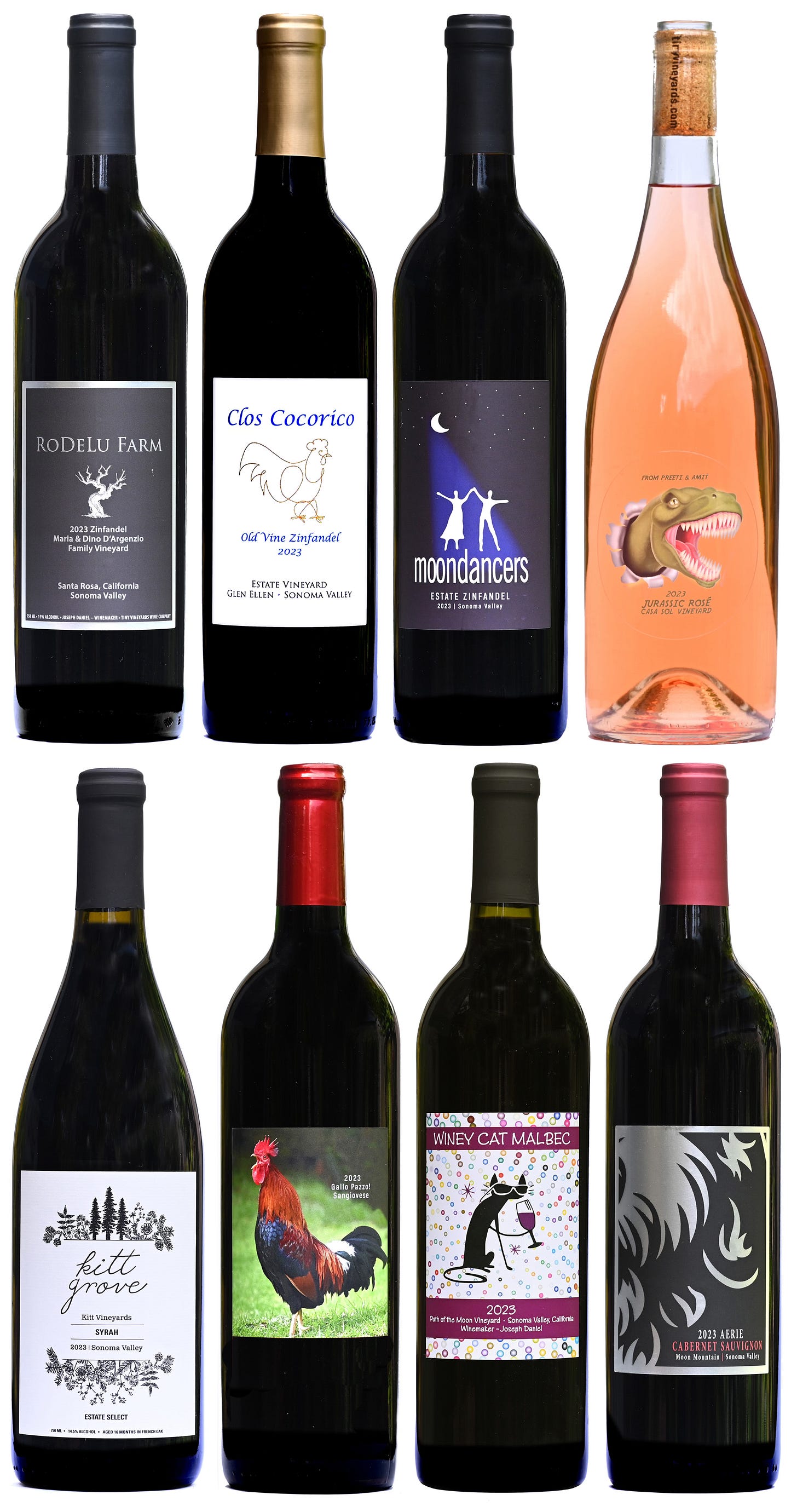I believe that the responsibility of the winemaker is to take that fruit and get it into the bottle as the most natural and purest expression of that vineyard, of the grape varietal or blend, and of the vintage. ~ Robert M. Parker, Jr., Founder of the Wine Advocate
There are no great enologists. Only good grapes. ~Michel Rolland, Oenologist
Your own private barrel of wine
Ten days ago we bottled 452 cases of wine which, along with another small lot of 47 cases bottled shortly after harvest, made up my entire 2023 vintage to be marketed under the Tiny Vineyards Wine Company label. There is, for the first time, a Zinfandel varietal and a Syrah varietal. There is also a Cabernet Sauvignon, a Zin Rosé (which we released last spring), and a Red Blend I’d made several times before, always anticipating what each new vintage might bring.
But there are another 290 cases I made at the same time that weren’t counted in the above and wouldn’t be sold under the Tiny Vineyards Wine Company label, but were themselves unique expressions of that very same 2023 vintage. These were the wines I made for private clients—three different Zinfandel varietals, a Grenache/Syrah Rosé, a Syrah varietal, a Sangiovese, a Malbec, and a Cabernet Sauvignon. Can’t tell you who they belong to, or where the vineyard is that they came from, that’s what “private” means. But here’s a look at their bottles.
For me, making a barrel of wine for a private client—usually out of grapes which that person has nurtured along for an entire season in their own vineyard—is one of the most rewarding aspects of being a winemaker. I love the anticipation that grows, and the back and forth between me and the client as we toss around label names and design, agree on the style of wine we’re after, and wonder what it will take to get there when we begin to navigate the influences of terroir, irrigation and vine management, and possible extreme weather events that might (read that seemingly always) occur—from late freezes and wind storms during bloom, to atmospheric rivers and flooding, to heat domes and drought, even to wildfire and smoke taint.
It’s always a challenge and maybe not for the risk adverse. But it’s worth every moment of my time over the two years it takes to handcraft a wine, and for my client, every penny of their investment if they have the resilience of a farmer, the curiosity of an adventurer, the heart of a romantic and the soul of a poet.

Folks end up owning a vineyard in different ways and for different reasons. For some, the idea of living in wine country simply begs the inclusion of a small vineyard as a part of their surrounding, so they plant one. Others end up buying a first or second home that already has a vineyard put in by the previous owner or developer. For many of them, having that vineyard is a big part of why they bought the property in the first place. And for a few it’s little more than apropos landscaping.
Regardless, every year a vineyard requires a certain amount of care and maintenance. And every year there’s that inevitable crop of thousands—maybe tens or hundreds of thousands—of juicy grapes demanding to be harvested. At first it’s a romantic endeavor. I mean, owning your own vineyard and making your own wine… that is decidedly cool!
But it’s also work. A lot of work. And often by the third or fourth vintage the gloss is off the grape, so to speak, and many tiny vineyard owners are looking for someone to prune, sucker, mow, monitor irrigation, spray for mildew, thin canes, hedge canopies, do leaf removal, test for Brix and ascertain ripeness, facilitate harvest, crush grapes, run labs, control alcoholic fermentation, press must, barrel wine, induce malolactic fermentation, monitor SO2 and microbial stability, rack, age, clarify, pump, bottle, cork, label and store. Whew!
Every deal is different when I contract with someone to make them a barrel of wine, which is 60 gallons and usually requires about 1,000 pounds of grapes. This results in 25 cases, which is 300 bottles of wine. But sometimes folks don’t want a barrel’s worth, sometimes it’s two. Or sometimes it’s just a small 30-gallon barrel or a dozen or so cases. But the most common arrangement is a single barrel—300 bottles of privately labeled wine per year seems to be the sweet spot for personal consumption and gift giving—and most of the time (but not always) it involves using grapes they’ve grown in their own vineyard adding to the overall value of the experience.
And, because you’re wondering, contracting for a custom handcrafted barrel of wine from the buyer’s grapes, bottled with a custom label, premium cork and metallic capsule, costs the buyer on average about $20 a bottle, all in.
But here’s the fine print. I can only handle a certain number of private clients a year, so I’m picky about what I agree to do. A good arrangement is someone who wants a full barrel made, but two or more barrels is even better. Or they grow enough grapes in their vineyard that there are extras for me after using what is necessary to make their barrel. There are several reasons for this. I try to end up with at least a ton of grapes from every harvest I do as that is the yield where the financial efficiencies in boutique winemaking kick in, and the volume at which better wine can be made. So, if available, two to three tons is even better. Those extra grapes give me the ability to blend wines with reciprocal private clients or supplement shortfalls.
And finally, varietal is certainly a determining factor. I’m less inspired with the same old same olds. I’m looking for exceptional vineyards, unique clones, favorable terroirs, and just about anything Italian or Spanish—particularly whites. And I’d really like to add a Pinot Noir to the mix.
However, this newsletter really isn’t a pitch for more private clients, I love the ones I have. I just wanted you to see an unheralded aspect of what I do, and look into my thinking as a winemaker and a businessman trying to weave all the parts together.
But if by chance all the stars align and you’re looking for a winemaker…


